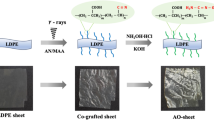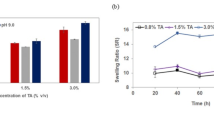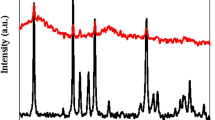Abstract
In this study, a novel poly(vinyl alcohol) (PVA) membrane modified with L-glutamic acid was synthesized using poly(ethylene glycol) (PEG) as a porogen to increase the surface area and improve Cu(II) adsorption. The phase separation between PVA and PEG induced pore formation, extending from the surface into the interior. PEG also acted as a plasticizer, increasing polymer chain flexibility. The effects of the PEG content on the structural and physicochemical properties were analyzed via water absorption, FT-IR, TGA, XRD, and SEM. The results showed that the incorporation of PEG significantly influenced the material properties. Additionally, adsorption, desorption, kinetic, and isotherm studies were conducted to evaluate the adsorption process. The Cu(II) adsorption capacity increased from 31.8 mg/g to 51.1 mg/g with an initial Cu(II) concentration of 95.0 mg/L. The adsorption equilibrium followed the Freundlich isotherm model, suggesting a heterogeneous surface with various adsorption sites. Kinetic analysis revealed pseudo-second-order kinetics. Desorption studies revealed efficient Cu(II) release in 2 M HNO3 within 150 min, resulting in an 81.9% desorption efficiency. Thermal analysis revealed a lower degradation range (262 °C) compared to that of pure PVA (339 °C), which was attributed to the increased surface area. Additionally, the incorporation of PEG reduced the crystallinity of PVA-c-Glu/PEG. These findings highlight the potential of PEG-modified porous PVA for sustainable heavy metal removal in environmental applications.
This is a preview of subscription content, access via your institution
Access options
Subscribe to this journal
Receive 12 print issues and online access
$259.00 per year
only $21.58 per issue
Buy this article
- Purchase on SpringerLink
- Instant access to full article PDF
Prices may be subject to local taxes which are calculated during checkout












Similar content being viewed by others
References
Chai WS, Cheun JY, Kumar PS, Mubashir M, Majeed Z, Banat F, et al. A review on conventional and novel materials towards heavy metal adsorption in wastewater treatment application. J Clean Prod. 2021;296:126589.
Mitra S, Chakraborty AJ, Tareq AM, Emran TB, Nainu F, Khusro A, et al. Impact of heavy metals on the environment and human health: Novel therapeutic insights to counter the toxicity. J King Saud Univ-Sci. 2022;34:101865.
Li AY, Deng H, Jiang YH, Ye CH, Yu BG, Zhou XL, et al. Superefficient removal of heavy metals from wastewater by Mg-loaded biochars: Adsorption characteristics and removal mechanisms. Langmuir. 2020;36:9160–74.
Karaer H, Kaya İ. Synthesis, characterization and using at the copper adsorption of chitosan/polyvinyl alcohol magnetic composite. J Mol Liq. 2017;230:152–62.
Deering TB, Dickson ER, Fleming CR, Geall MG, McCall JT, Baggenstoss AH. Effect of D-penicillamine on copper retention in patients with primary biliary cirrhosis. Gastroenterology. 1977;72:1208–12.
Gross JrJB, Ludwig J, Wiesner RH, McCall JT, LaRusso NF. Abnormalities in tests of copper metabolism in primary sclerosing cholangitis. Gastroenterology. 1985;89:272–8.
John BC, Viswambaram VA, Raj SS, Mankunipoyil SA. Adsorptive removal of Cr (VI) using mesoporous iron-aluminum oxyhydroxide-polyvinyl alcohol self-supporting film: Kinetics, optimization studies and mechanism. Mater Today Commun. 2023;34:105315.
Renu, Agarwal M, Singh K. Heavy metal removal from wastewater using various adsorbents: a review. J Water Reuse Desalin. 2017;7:387–419.
Prathna TC, Raichur AM. Fluoride removal from aqueous solutions using poly (styrene sulfonate)/nanoalumina multilayer thin films. Glob Chall. 2018;2:1700064.
Hu D, Lian Z, Xian H, Jiang R, Wang N, Weng Y, et al. Adsorption of Pb (II) from aqueous solution by polyacrylic acid grafted magnetic chitosan nanocomposite. Int J Biol Macromol. 2020;154:1537–47.
Song Q, Gao J, Lin Y, Zhang Z, Xiang Y. Synthesis of cross-linking chitosan-PVA composite hydrogel and adsorption of Cu (II) ions. Water Sci Technol. 2020;81:1063–70.
He W, Yu Q, Wang N, Ouyang X-k. Efficient adsorption of Cu (II) from aqueous solutions by acid-resistant and recyclable ethylenediamine tetraacetic acid-grafted polyvinyl alcohol/chitosan beads. J Mol Liq. 2020;316:113856.
Lakkaboyana SK, Soontarapa K, Asmel NK, Kumar V, Marella RK, Yuzir A, et al. Synthesis and characterization of Cu (OH) 2-NWs-PVA-AC nano-composite and its use as an efficient adsorbent for removal of methylene blue. Sci Rep. 2021;11:5686.
Jamnongkan T, Singcharoen K. Towards novel adsorbents: the ratio of PVA/chitosan blended hydrogels on the copper (II) ion adsorption. Energy Procedia. 2016;89:299–306.
Zarghami S, Kazemimoghadam M, Mohammadi T. Cu (II) removal enhancement from aqueous solutions using ion-imprinted membrane technique. Chem Pap. 2014;68:809–15.
Li L, Xu X, Liu L, Song P, Cao Q, Xu Z, et al. Water governs the mechanical properties of poly (vinyl alcohol). Polymer. 2021;213:123330.
Yoon JY, Zhang H, Kim YK, Harbottle D, Lee JW. A high-strength polyvinyl alcohol hydrogel membrane crosslinked by sulfosuccinic acid for strontium removal via filtration. J Environ Chem Eng. 2019;7:102824.
Zeng L, Liu Q, Xu W, Wang G, Xu Y, Liang E. Graft copolymerization of crosslinked polyvinyl alcohol with acrylonitrile and its amidoxime modification as a heavy metal ion adsorbent. J Polym Environ. 2020;28:116–22.
Bolto B, Tran T, Hoang M, Xie Z. Crosslinked poly (vinyl alcohol) membranes. Prog Polym Sci. 2009;34:969–81.
Vu Trung N, Pham Thi N, Nguyen TH, Nguyen MN, Tran Anh D, Nguyen Trung T, et al. Tuning the thermal and mechanical properties of poly (vinyl alcohol) with 2, 5-furandicarboxylic acid acting as a biobased crosslinking agent. Polym J. 2022;54:335–43.
El-Nahas AM, Hirao K. Complexation of Li+ and Cu+ with HX (X= F, Cl, OH, SH, NH2, and PH2) Molecules by B3LYP and CCSD (T) Methods. J Phys Chem A. 2000;104:138–44.
Ghaee A, Shariaty-Niassar M, Barzin J, Matsuura T. Effects of chitosan membrane morphology on copper ion adsorption. Chem Eng J. 2010;165:46–55.
Abu Ghalia M, Dahman Y. Radiation crosslinking polymerization of poly (vinyl alcohol) and poly (ethylene glycol) with controlled drug release. J Polym Res. 2015;22:1–9.
Falqi FH, Bin-Dahman OA, Hussain M, Al-Harthi MA. Preparation of miscible PVA/PEG blends and effect of graphene concentration on thermal, crystallization, morphological, and mechanical properties of PVA/PEG (10 wt%) blend. Int J Polym Sci. 2018;2018:8527693.
Lim L, Wan LS. The effect of plasticizers on the properties of polyvinyl alcohol films. Drug Dev Ind Pharm. 1994;20:1007–20.
Cao N, Yang X, Fu Y. Effects of various plasticizers on mechanical and water vapor barrier properties of gelatin films. Food Hydrocoll. 2009;23:729–35.
Narkkun T, Boonying P, Yuenyao C, Amnuaypanich S. Green synthesis of porous polyvinyl alcohol membranes functionalized with l-arginine and their application in the removal of 4-nitrophenol from aqueous solution. J Appl Polym Sci. 2019;136:47835.
Torrik E, Soleimani M, Ravanchi MT. Application of kinetic models for heavy metal adsorption in the single and multicomponent adsorption system. Int J Environ Res. 2019;13:813–28.
Matouq M, Jildeh N, Qtaishat M, Hindiyeh M, Al Syouf MQ. The adsorption kinetics and modeling for heavy metals removal from wastewater by Moringa pods. J Environ Chem Eng. 2015;3:775–84.
Wang J, Guo X. Adsorption kinetics and isotherm models of heavy metals by various adsorbents: an overview. Crit Rev Environ Sci Technol. 2023;53:1837–65.
Obaid SA, editor Langmuir, Freundlich and Tamkin adsorption isotherms and kinetics for the removal aartichoke tournefortii straw from agricultural waste. Journal of Physics: Conference Series; IOP Publishing; 2020.
Chen X, Hossain MF, Duan C, Lu J, Tsang YF, Islam MS, et al. Isotherm models for adsorption of heavy metals from water-a review. Chemosphere. 2022;307:135545.
Sadeek SA, Negm NA, Hefni HH, Wahab MMA. Metal adsorption by agricultural biosorbents: adsorption isotherm, kinetic and biosorbents chemical structures. Int J Biol Macromol. 2015;81:400–9.
Samadi N, Hasanzadeh R, Rasad M. Adsorption isotherms, kinetic, and desorption studies on removal of toxic metal ions from aqueous solutions by polymeric adsorbent. J Appl Polymer Sci. 2015;132:41642.
Vo TS, Hossain MM, Jeong HM, Kim K. Heavy metal removal applications using adsorptive membranes. Nano Convergence. 2020;7:36.
Mohammed G, El Sayed AM. Structural, morphological, optical and dielectric properties of M3+/PVA/PEG SPE Films (M= La, Y, Fe or Ir). Polym Adv Technol. 2019;30:698–712.
AlZaidy GA. Impact of hybrid aluminum oxide/titanium dioxide nanoparticles on the structural, optical, and electrical properties of polyvinyl alcohol/polyethylene glycol nanocomposites for flexible optoelectronic devices. Ceram Int. 2024;50:23483–92.
Mansur HS, Sadahira CM, Souza AN, Mansur AA. FTIR spectroscopy characterization of poly (vinyl alcohol) hydrogel with different hydrolysis degree and chemically crosslinked with glutaraldehyde. Mater Sci Eng C. 2008;28:539–48.
Hafidi Y, El Hatka H, Schmitz D, Biel M, Ittobane N. Elaboration and characterization of biodegradable poly (aspartic-co-glutamic acid) hydrogels as soil additives with different crosslinkers. Polym Polym Compos. 2024;32:09673911241234838.
Pham Thi N, Ho LHT, Vu Trung N, Tran HA, Nguyen Ngoc M, Nguyen Thu H, et al. Investigation of the effects of cellulose nanofiber on the properties of poly (vinyl alcohol) crosslinked by 2, 5-furandicarboxylic acid. J Elastomers Plast. 2024;56:194–210.
Huang C-W, Chiu S-C, Lin W-H, Li Y-Y. Preparation and characterization of porous carbon nanofibers from thermal decomposition of poly (ethylene glycol). J Phys Chem C. 2008;112:926–31.
Ricciardi R, Auriemma F, De Rosa C, Lauprêtre F. X-ray diffraction analysis of poly (vinyl alcohol) hydrogels, obtained by freezing and thawing techniques. Macromolecules. 2004;37:1921–7.
Sakellariou P, Hassan A, Rowe R. Interactions and partitioning of diluents/plasticizers in hydroxypropyl methylcellulose and polyvinyl alcohol homopolymers and blends. Part III: polyethylene glycol 400. Colloid Polym Sci. 1994;272:220–7.
Navarro R, Guzmán J, Saucedo I, Revilla J, Guibal E. Recovery of metal ions by chitosan: sorption mechanisms and influence of metal speciation. Macromol Biosci. 2003;3:552–61.
Xiong Q, Zhang F. Study on the performance of composite adsorption of Cu2+ by chitosan/β-cyclodextrin cross-linked zeolite. Sustainability. 2022;14:2106.
Jiang M, Wang J, Li L, Pan K, Cao B. Poly (N, N-dimethylaminoethyl methacrylate) modification of a regenerated cellulose membrane using ATRP method for copper (II) ion removal. RSC Adv. 2013;3:20625–32.
Chen JH, Lin H, Luo ZH, He YS, Li GP. Cu (II)-imprinted porous film adsorbent Cu–PVA–SA has high uptake capacity for removal of Cu (II) ions from aqueous solution. Desalination. 2011;277:265–73.
Acknowledgements
This research is funded by the Ministry of Education and Training of Vietnam under grant number B2024-BKA-05.
Author information
Authors and Affiliations
Corresponding author
Ethics declarations
Conflict of interest
The authors declare no competing interests.
Additional information
Publisher’s note Springer Nature remains neutral with regard to jurisdictional claims in published maps and institutional affiliations.
Rights and permissions
Springer Nature or its licensor (e.g. a society or other partner) holds exclusive rights to this article under a publishing agreement with the author(s) or other rightsholder(s); author self-archiving of the accepted manuscript version of this article is solely governed by the terms of such publishing agreement and applicable law.
About this article
Cite this article
Truong Hoai, N., Ho Le Hanh, T., Nguyen Thi Thu, H. et al. Investigation of the effects of poly(ethylene glycol) on the properties of a novel poly(vinyl alcohol) membrane modified with L-glutamic acid for copper removal. Polym J (2025). https://doi.org/10.1038/s41428-025-01093-x
Received:
Revised:
Accepted:
Published:
DOI: https://doi.org/10.1038/s41428-025-01093-x



